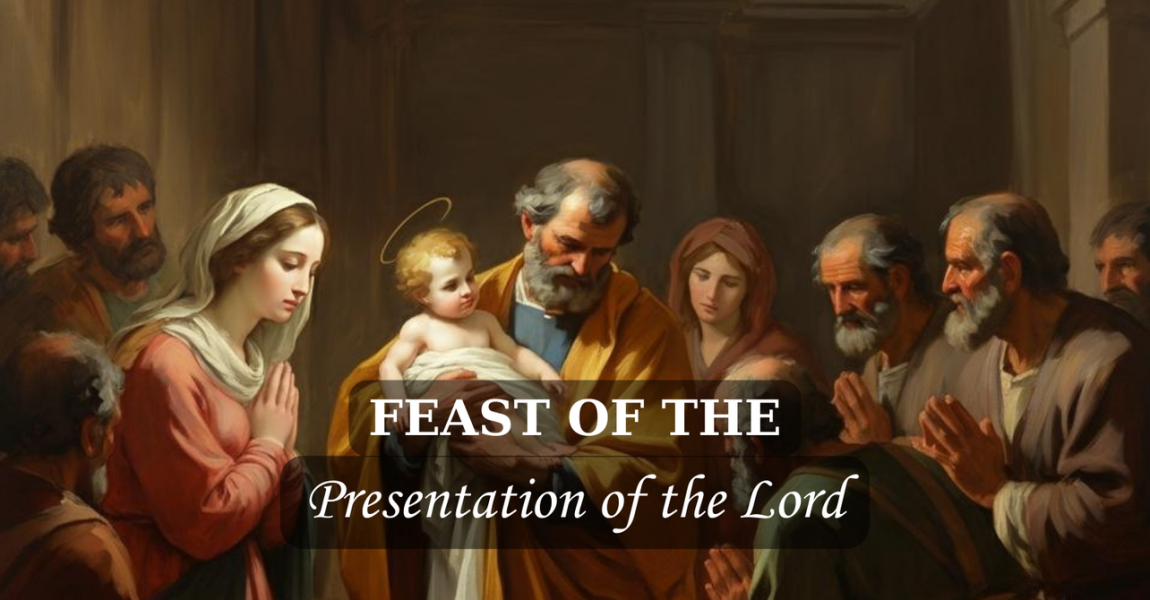
Ml 3:1-4; Ps 23; Heb 2:14-18; Lk 2:22-40

COMMENTARY
The Mission of the Divine Child – Light and Hope of the Gentiles and His People
The liturgical feast of the Presentation of the Lord is celebrated every year on February 2, forty days after Christmas, to commemorate an important event, when Mary and Joseph with the baby Jesus went to the Temple of Jerusalem for the mother’s ritual purification forty days after giving birth, according to the Law of Moses (cf. Lv 12:3-4), as well as “to present Him [Jesus] to the Lord.” By divine Providence, this year the feast coincides with the fourth Sunday of Ordinary Time. So, the Gospel proclaimed in the Mass tells us, once again, the episode of the Presentation of Jesus at the Temple, offering us the opportunity to delve into some relevant aspects of the life and mission of Jesus, as highlighted in the story of the evangelist Luke. This reflection could also be useful for consecrated persons on the World Day dedicated to them, for a desirable missionary spiritual renewal in the Jubilee, as well as for all those who are involved in the Pontifical Missionary Union, whose annual feast is celebrated today in many churches of the world, particularly in Africa.
1. The Context of the Fulfillment of the Divine Law
First, St. Luke emphasized the faithfulness of the Holy Family in fulfilling the precepts of the Law in their lives. This aspect is highlighted at the beginning of the story with the repeated reference to the Law (called “of Moses” and “of the Lord”) as a motivation for their actions, as well as at the end with the particular phrase: “When they had fulfilled everything according to the law of the Lord, they returned… ” . The presentation of Jesus at the Temple therefore takes place in a context of the perfect fulfillment of what God commanded his people through Moses.
In this regard, it is important to note that Mary and Joseph, while being aware of the extraordinary mission of their child, submit to the traditions and laws of their people. This, moreover, is also reflected in their going to the Temple of Jerusalem for Easter every year, as reported by St. Luke (Lk 2:41). In the attitude of Mary and Joseph we can then glimpse that of Jesus who will declare that he came not to abolish the divine Law, but to bring it to fulfillment. This offers a precious lesson for us, the faithful of God today: the great value and importance of carrying out religious practices with obedience and fidelity, which help us to live in constant communion with God and unite us to God’s plan.
Furthermore, Mary and Joseph offer “a pair of turtledoves or two young pigeons.” This is the offering for the purification of the mother after giving birth, prescribed by Mosaic Law for those who do not have economic means (cf. Lev 12:6, 8: “When the days of her purification for a son or for a daughter are completed, she shall bring to the priest at the entrance of the tent of meeting a year-old lamb for a burnt offering, and a young pigeon or a turtledove for a sin offering. […] If she cannot afford a lamb, she shall take two turtledoves or two young pigeons: one for a burnt offering and the other for a sin offering.”) The note on their offering therefore gives us a glimpse, on the one hand, of the poverty of the family of Nazareth, and on the other, of the beauty of their willingness to serve God with what they had. Mary, Joseph and Jesus can be considered part of God’s poor, like the widow who offered her only two coins to God in the Temple. Jesus will declare that they, the poor of the Lord, will be the privileged recipients of the Kingdom of God; at the same time, they will also be the protagonists in fulfilling God’s will and therefore in carrying forward the divine plan for the salvation of humanity. Let us learn, especially from Mary, Joseph and Jesus, to renew our life of faith as the poor of God.
2. Christ – Light and Hope of the Gentiles and of His people
When Jesus was presented in the Temple, two mysterious but emblematic characters, the elderly Simeon and the prophetess-widow Anna, greeted him. They, one man and one woman, are complementary, and thus represent all humanity awaiting divine salvation. In particular, they represent all those who, despite the ups and downs of life, place their hope always and only in God. The Lord who, being rich, became poor for us and among us, that is, poor for/between Simeon and Anna, revealed himself above all to these two, and then through their testimony reveals himself to the world.
Indeed, when Simeon takes Jesus in his arms, he speaks words of joy and recognition. Under the inspiration of the Holy Spirit, he declares that Jesus is “a light to reveal himself to the Gentiles” and “the glory of His people, Israel.” This passage contains a message of hope and universality: the salvation that God offers in Christ is not limited only to the chosen people of Israel, but is for everyone. The fulfillment of God’s promises with and in Christ goes beyond all human expectations, and consequently, Christ’s mission always extends beyond every visible boundary of the earth. So much so that He will ask his disciples to go throughout the world to teach (literally to make disciples) all peoples, thus collaborating with Himself in this mission of revealing himself to the Gentiles.
3. “You are the light of the world” (Mt 5:14)
Simeon’s words lead us to reflect again on the mission of Jesus and, consequently, of Christians, his disciples today, in the context of Jubilee 2025. He is not only the Savior of Israel, but the Savior of the world. The light of Christ must illuminate the darkness of all our lives and all our societies, in order to promote a divine spiritual renewal. How often do we live in the shadow of fear, division, lack of hope? As He himself revealed the identity of his followers: “You are the light of the world”(Mt 5:14), we all, as Christians, are called to bring the light of Christ’s Gospel into our families, our communities and the world. Let us ask ourselves: how can we be bearers of this light? How can we transform our daily life into a reflection of the light of Christ?
Let us fix our eyes once again on the Lord, presented and revealed in the Temple. Let us also observe and learn from the example of Mary, Joseph, Simeon and Anna. Like each of them, we may live our life with God in obedience and faithfulness to religious practices, in listening to the Spirit and in persevering in waiting for Christ, “the consolation of Israel,” in a taste for prayer and worship, as well as in joyfully sharing Jesus with others. The divine Light that Simeon and Anna recognize is not only for us, but is an invitation to all to undertake a journey of faith and mission. We are called to bring light, to be witnesses of the Gospel in the world, and to enlighten those around us. In a world where despair and darkness seem to prevail, we are called to become more and more bearers of light, witnesses of love, hope and mercy. May our words and actions always be guided by the Holy Spirit to be able to illuminate, inspire, and bring everyone back to the encounter with the Lord who comes!
Useful points to consider:
FRANCIS, HOMILY 2 February 2017 FEAST OF THE PRESENTATION OF THE LORD – XXI WORLD DAY OF CONSECRATED LIFE
Today’s liturgy tells us that in that rite, the Lord, forty days after his birth, “outwardly was fulfilling the Law, but in reality he was coming to meet his believing people” (Roman Missal, 2 February, Introduction to the Entrance Procession). This encounter of God with his people brings joy and renews hope.
Simeon’s canticle is the hymn of the believer, who at the end of his days can exclaim: “It is true, hope in God never disappoints” (cf. Rm 5:5). God never deceives us. Simeon and Anna, in their old age, were capable of a new fruitfulness, and they testify to this in song. Life is worth living in hope, because the Lord keeps his promise. Jesus himself will later explain this promise in the synagogue of Nazareth: the sick, prisoners, those who are alone, the poor, the elderly and sinners, all are invited to take up this same hymn of hope. Jesus is with them, Jesus is with us (cf. Lk 4:18-19).
All of us are aware of the multicultural transformation we are experiencing; no one doubts this. Hence, it is all the more important for consecrated men and women to be one with Jesus, in their lives and in the midst of these great changes. Our mission – in accordance with each particular charism – reminds us that we are called to be a leaven in this dough. Perhaps there are better brands of flour, but the Lord has called us to be leaven here and now, with the challenges we face. Not on the defensive or motivated by fear, but with our hands on the plough, helping the wheat to grow, even though it has frequently been sown among weeds. Putting Jesus in the midst of his people means having a contemplative heart, one capable of discerning how God is walking through the streets of our cities, our towns and our neighbourhoods. Putting Jesus in the midst of his people means taking up and carrying the crosses of our brothers and sisters. It means wanting to touch the wounds of Jesus in the wounds of a world in pain, which longs and cries out for healing.
Let us accompany Jesus as he goes forth to meet his people, to be in the midst of his people. Let us go forth, not with the complaining or anxiety of those who have forgotten how to prophesy because they failed to take up the dreams of their elders, but with serenity and songs of praise. Not with apprehension but with the patience of those who trust in the Spirit, the Lord of dreams and prophecy. In this way, let us share what is truly our own: the hymn that is born of hope.